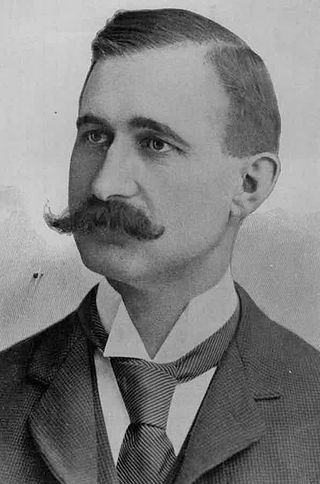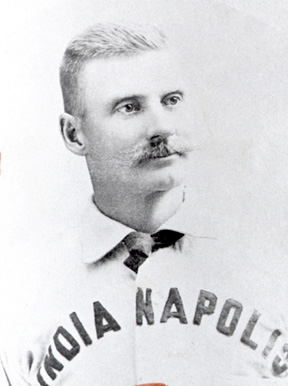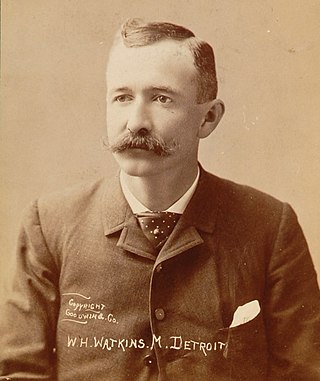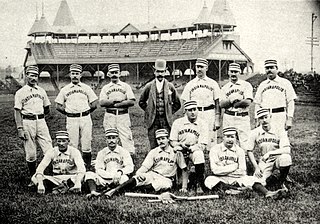At least three teams in minor league baseball have borne the name Indianapolis Hoosiers.
At least three teams in minor league baseball have borne the name Indianapolis Hoosiers.
The first Western League, which lasted only part of the 1885 season, included an Indianapolis Hoosiers team. This Hoosiers team won the 1885 Western League pennant.
Another Hoosiers minor-league team came into existence in 1894. It was a charter member of the third Western League, which became the American League in 1900. Despite winning three Western League pennants (1895, 1897, 1899), this team was contracted when the AL became an official major league in 1901.
One of the two Western Associations that existed in 1901 also had a team known as the Indianapolis Hoosiers. Both the team and league lasted only one season.

The American League of Professional Baseball Clubs, known simply as the American League (AL), is one of two leagues that make up Major League Baseball (MLB) in the United States and Canada. It developed from the Western League, a minor league based in the Great Lakes states, which eventually aspired to major league status. It is sometimes called the Junior Circuit because it claimed Major League status for the 1901 season, 25 years after the formation of the National League.

The Indianapolis Indians are a Minor League Baseball team of the International League (IL) and the Triple-A affiliate of the Pittsburgh Pirates. They are located in Indianapolis, Indiana, and play their home games at Victory Field, which opened in 1996. The Indians previously played at Owen J. Bush Stadium from 1931 to 1996 and at two versions of Washington Park from 1902 to 1931.

Samuel Luther "Big Sam" Thompson was an American professional baseball player from 1884 to 1898 and with a brief comeback in 1906. At 6 feet 2 inches (1.88 m), the Indiana native was one of the larger players of his day and was known for his prominent handlebar mustache. He played as a right fielder in Major League Baseball for the Detroit Wolverines (1885–1888), Philadelphia Phillies (1889–1898) and Detroit Tigers (1906). He was inducted into the Baseball Hall of Fame in 1974.

Frank Gibson Selee was an American Major League Baseball manager in the National League (NL). In his 16-year Major League career, he managed the Boston Beaneaters (1890–1901) and Chicago Orphans / Cubs (1902–1905), winning 1,284 games. Selee managed the Beaneaters during their 1890s run of five NL championships. His 1892 and 1898 teams each won 100 games, becoming the first teams to ever achieve the mark in baseball history ; their 102 wins in each season would not be surpassed by a National League team until 1902. After joining the Orphans, he helped build the team that would become the Cubs dynasty of the 1900s. He was elected to the National Baseball Hall of Fame in 1999.

John Wesley "Jack" Glasscock was an American shortstop in Major League Baseball who played for several teams from 1879 to 1895. Nicknamed "Pebbly Jack", he was the top player at his position in the 1880s during the sport's bare-handed era. He led the National League in fielding percentage seven times and in assists six times; he was the only shortstop to lead in fielding percentage and total chances in a season three different times until Luis Aparicio matched him. Ozzie Smith eventually surpassed Glasscock's marks in the 1980s; Glasscock also led the NL in double plays four times and in putouts twice. He won the 1890 batting title with a .336 average for the New York Giants and led the league in hits twice; in his final season he became the sixth major league player to make 2,000 hits. He was the first player to appear in over 600 games as a shortstop, and ended his career with major league records for games (1,628), putouts (2,821), assists (5,630), total chances (9,283), double plays (620) and fielding percentage (.910) at the position. When he retired he ranked fifth in major league history in games (1,736) and at bats (7,030), seventh in total bases (2,630) and eighth in doubles (313).
Indianapolis Hoosiers was the name of three major league and at least three minor league baseball clubs based in Indianapolis.
The Western League was the name of several minor league baseball leagues that operated between 1885 and 1900. These leagues were focused mainly in the Midwestern United States.
The Southern Association was a higher-level minor league in American organized baseball from 1901 through 1961. For most of its existence, the Southern Association was two steps below the Major Leagues; it was graded Class A (1902–1935), Class A1 (1936–1945) and Class AA (1946–1961). Although the SA was known as the Southern League through 1919, the later Double-A Southern League was not descended from the Southern Association; the modern SL came into existence in 1964 as the successor to the original South Atlantic ("Sally") League.

William Henry Watkins, sometimes known as "Wattie," or "Watty," was a Canadian-born baseball player, manager, executive and team owner whose career in organized baseball spanned 47 years from 1876 to 1922.

John Tomlinson Brush was an American baseball executive who is primarily remembered as the principal owner of the New York Giants franchise in Major League Baseball from late in the 1902 season until his death following the 1912 season. He also owned the Indianapolis Hoosiers in the late 1880s, followed by ownership of the Cincinnati Reds for a decade.
Michael Joseph Kelley was an American Major League Baseball first baseman. He played one season in the majors with the 1899 Louisville Colonels. He then forged a 30-year career as a manager in the minor leagues and became a legendary figure in the "Twin Cities" of Minneapolis–St. Paul.
Charles Augustus "Chub" Collins was a Canadian professional baseball player and politician. He played two seasons in Major League Baseball from 1884 to 1885 as a second baseman and shortstop for the Buffalo Bisons, Indianapolis Hoosiers, and Detroit Wolverines. He later served as the mayor of Dundas, Ontario, from 1901 to 1902.

Charles Carbitt Carr was an American baseball first baseman and manager. He played professional baseball from 1894 to 1919, including seven years in Major League Baseball with the Washington Senators (1898), Philadelphia Athletics (1901), Detroit Tigers (1903–1904), Cleveland Naps (1904–1905), Cincinnati Reds (1906), and Indianapolis Hoosiers (1914). Over his seven-year major league career, Carr had a .252 batting average with 493 hits, 106 extra base hits, and 240 runs batted in (RBIs).

James B. Donnelly was an American professional baseball player whose career spanned from 1884 to 1900. He played all or part of 11 seasons in Major League Baseball, principally as a third baseman, for nine different major league clubs. In his 11 major league seasons, Donnelly compiled a .230 career batting average and led the National League's third basemen with 73 errors in 1886 and 275 assists in 1887.
The following is a timeline of franchise evolution in Major League Baseball. The histories of franchises in the National Association of Base Ball Players (NABBP), National Association of Professional Base Ball Players (NA), Union Association (UA), and American Association (AA) before they joined the National League are also included. In 1900 the minor league Western League renamed itself the American League (AL). All of the 1899 Western League teams were a part of the transformation with the Saint Paul Apostles moving to Chicago and to play as the White Stockings. In 1901 the AL declared itself a Major League. For its inaugural major league season the AL dropped its teams in Indianapolis, Buffalo and Minneapolis and replaced them with franchises in Boston, Philadelphia, and Baltimore and the Kansas City Blues moved to Washington to play as the Senators.

Mortimer Martin "Mert" Hackett, was an American professional baseball catcher. He played in Major League Baseball from 1883 to 1887 for the Boston Beaneaters, Kansas City Cowboys, and Indianapolis Hoosiers. His older brother, Walter Hackett, and cousins Walter Clarkson, Dad Clarkson and Baseball Hall of Famers John Clarkson, Tim Keefe and Joe Kelley also played in the majors.

George Kaiserling was a Major League Baseball pitcher. Born and raised in Steubenville, Ohio, he played in the Federal League in 1914 for the Indianapolis Hoosiers, moving with them to New Jersey in 1915 where they became the Newark Peppers. Kaiserling won 17 games for pennant-winning Indianapolis in 1914 and finished seventh in the Federal League with a 2.24 earned run average (ERA) in 1914. After pitching for a minor league team in 1916, he contracted tuberculosis the following year, dying of the disease at age 24 in 1918.

The St. Louis Maroons were a professional baseball club based in St. Louis, Missouri, from 1884–1886. The club, established by Henry Lucas, were the one near-major league quality entry in the Union Association, a league that lasted only one season, due in large part to the dominance of the Maroons. When the UA folded after playing just one season, the Maroons joined the National League. In 1887 the Maroons relocated to Indianapolis and became the Indianapolis Hoosiers, where they played three more seasons before folding.

William Tolan Gray, also spelled Bill Grey, was an American third baseman and utility player in Major League Baseball between 1890 and 1898. He played two seasons each with the Philadelphia Phillies and the Cincinnati Reds, and was the starter at third base for the Pittsburgh Pirates during his final season in the major leagues. He was officially listed as standing 5 feet 11 inches (180 cm) and weighing 175 pounds (79 kg).
The Kansas City Blues was the primary moniker of the minor league baseball teams based in Kansas City, Missouri between 1885 and 1901. The Kansas City minor league teams played as members of the Class A level Western League in 1885 and 1887, the Western Association in 1888, 1890 and 1891, Western League in 1892, Western Association in 1893 and Western League from 1894 to 1899. The Blues transitioned to the American League in 1900, a year before the league became a major league, before returning to the Western League in 1901. The American League Blues evolved into today's Minnesota Twins. The minor league team played under the "Cowboys" moniker in 1885, 1887 and 1894. The Kansas City Blues/Cowboys played home games at Exposition Park.